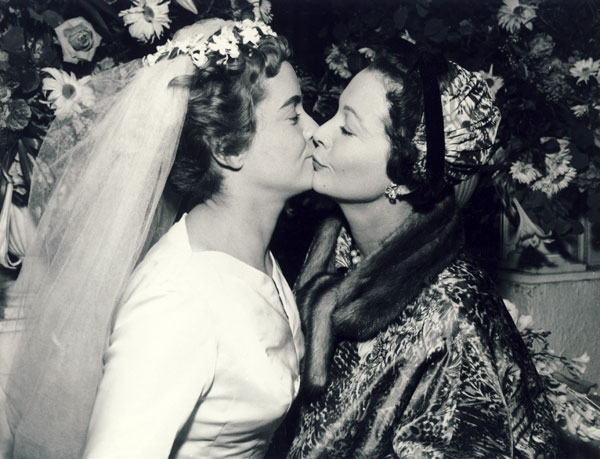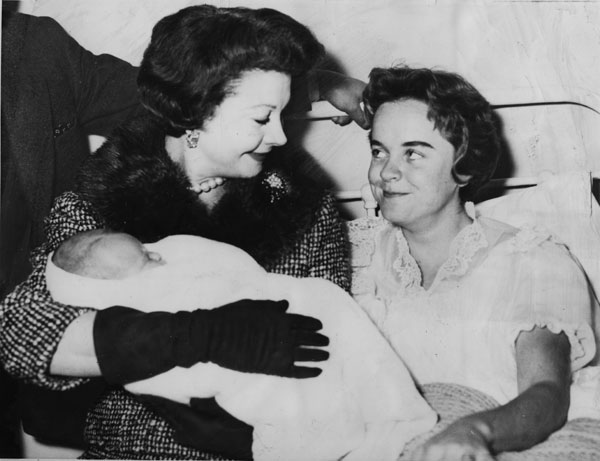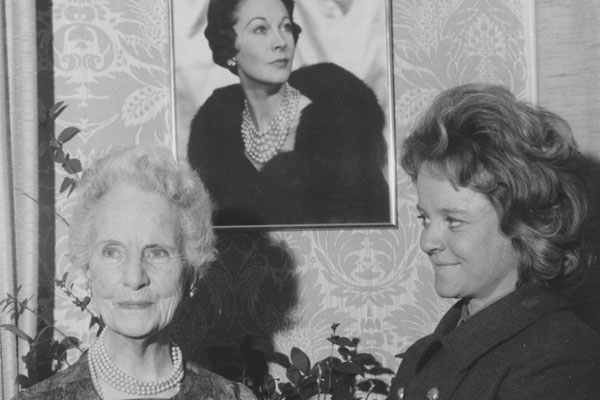by Shirley Gott
New Idea (Australia), December 25, 1963
**Thanks to Judy for sharing this article.
featured general discussion vivien leigh
It was with sadness that I learned last week of the death of Suzanne Farrington, Vivien Leigh’s only child. She passed away presumably at home in Lower Zeals, Wiltshire, of unstated causes at age 81. Many people know of her, but few outside her family and immediate circle seem to know much about her. The death announcement in the Telegraph told us that she lived a life of love and laughter and is survived by her three sons, 12 grandchildren and numerous friends, while a longer obituary in the same paper focused more on Suzanne’s tenuous relationship with her famous mother than her individual accomplishments as a woman, wife and mother.
Who was Suzanne Farrington, really? While conducting research for Vivien Leigh: An Intimate Portrait, meeting Suzanne was like trying to reach the summit of Mount Everest when I wasn’t an experienced climber. There was a shroud of protective secrecy surrounding her that was carefully held in place by several gatekeepers.
“Have you talked to Suzie?” many people asked me. I had not, I said, but I hoped to. I questioned everyone I interviewed about her. Is she nice? What’s she like? She was indeed nice, they said, but she never talks about Vivien, “I mean, she was basically abandoned by her mother.” And there was often the added reminder that “she doesn’t look much like Vivien.” Trader Faulkner told me of an embarrassing gaffe he made when he met Suzanne once at Notley Abbey. “You’re not like your mother, are you?” he said to her, without thinking. “No,” she responded. “Thank God.”
Whether Suzanne’s reluctance to talk about her life stemmed from lingering feelings of resentment over the atypical relationship she shared with Vivien, or the constant and unfair comparisons to her mother, or some other reason entirely, I was aware from the beginning and respected her want for privacy. And so I explained to my interviewees that my goal was not to push for information about her private life but rather to get her blessing for a project that was very near and dear to me. See, in my experience, I find it better to meet people in person rather than rely on formal letters through lawyers or other intermediaries. I feel that a face-to-face meeting (or even a direct email or phone call) allows people to see what I’m really about and helps me to assure them that I’m not some random crazy person out to write a tabloid-style exposé on their famous relative or friend.
 Vivien and Suzanne at Suzanne’s wedding to Robin Farrington, December 1957
Vivien and Suzanne at Suzanne’s wedding to Robin Farrington, December 1957
There were several of Vivien Leigh’s letters in the Laurence Olivier Archive that I was determined to use; I felt that even if I couldn’t quote the letters in full, extracts would add something special to my book. This being my first foray into book writing, I wanted to make sure I did everything the right away. I figured the powers that be would recognize that if I had wanted to write some sort of trashy tell-all about Vivien, I wouldn’t even bother asking permission for anything. Right? So I carefully drafted a letter to Suzanne stating my mission and telling her about myself and the work I’d done so far. Then I sent the letter via her lawyer, who passed it on for me (though not, I strongly suspect, with any sort of word of encouragement. It is, after all, a firm that represents high profile clients like Rupert Murdoch). Then I waited. And waited, and waited some more. There were moments of great stress thinking about what she might say, if anything. I even remember dreaming about it once – of receiving a letter that said yes, you can use my mother’s letters! After about three months, I received a curt email from the lawyer saying he regretted to inform me that neither Suzanne nor Joan Plowright (who I hadn’t enquired about) was willing to let me use anything under their copyright. No explanation as to the reason why. Just a swift “No, sorry.” I was at the BFI Library going through Vivien’s letters in the Jack Merivale papers at the time, and I went into the bathroom and cried. It seemed like the worst thing that could happen; that possibly all the time and effort I’d already put in to research and making contacts was for nothing and this book would never come to fruition.
It was a crushing blow, but I refused give up.
Some of my interviewees, after our meetings, were eager to help. Vivien’s sister-in-law, Hester St John-Ives (who sadly passed away just after Christmas last year), was friendly with Suzanne and offered to phone and vouch for me. She wasn’t able to reach her, but I greatly appreciated the kind effort. Others flat out told me that Suzanne wouldn’t want to meet with me; and there were also those who didn’t feel like they could even talk about Vivien because they were good friends with Suzanne and had already talked to x biographer ages ago.
 Vivien with Suzanne and first-born grandchild, Neville Farrington, 1958
Vivien with Suzanne and first-born grandchild, Neville Farrington, 1958
“I wish you had been doing this when Peter Hiley was still alive,” Hester said to me while we had lunch at her house in Devon one January day back in 2013. Hiley, who had worked for both the Vivien Leigh and Laurence Olivier estates since the two of them were still alive and married to one another, had been the link between biographers like Hugo Vickers (and I assume others) and Suzanne. Alas, Hiley died in 2008, just a year after I launched this website and a year before I decided I was going to embark on the journey of publishing a book about Vivien. Full disclosure: in 2009 I hadn’t the slightest idea how to go about getting a book published so even if Hiley had still been with us, I probably wouldn’t have known to get in contact anyway.
In the end, I never got to meet Suzanne. But as Mick Jagger once aptly pointed out, “You can’t always get what you want. But if you try, sometimes you just might find you get what you need.” Days before my submission deadline, I was contacted by Hugo Vickers who had encouraged my enthusiasm from the beginning. Having presented Suzanne with second a letter I had written, she finally said yes. For that I’m eternally grateful.
This brings us back to the question “Who was Suzanne?” As a Vivien Leigh fan, I know I speak for many when I say that it would have been great if she’d opened up about her mom in a documentary or something. As a writer, in the absence of a direct interview, I relied on interviews and quotes she gave to the press in the years before Vivien’s death (this one continues to be one of the most popular posts on this site for some reason).
 Suzanne and her grandmother, Gertrude Hartley, early 1970s
Suzanne and her grandmother, Gertrude Hartley, early 1970s
I think it’s natural for us fans to wish Suzanne had spoken more about her relationship with Vivien, but I also believe her silence is to be equally respected and admired. By keeping herself from the spotlight, Suzanne was able to live her own life away from Vivien’s ever-present shadow. She put her family and friends first, and reaped the benefits. Those of us who never had the privilege of meeting her may never know who she really was. But she did bequeath us with an extraordinary gift in the form of her mother’s papers, now safely ensconced at the Victoria & Albert Museum in London. And that, I think, is more than enough.
If any of you had the privilege of meeting Suzanne, please feel free to comment. I’d love to hear your story!
♠ ♣ ♠ ♣ ♠
Gertrude Hartley photographed in 1958
While helping a good friend sort through some of the vintage magazines in his collection recently, I spotted this unique article in a 1958 issue of the The Tatler & Bystander, a weekly magazine catering mostly to upper-middle class and wealthy British women. It profiles Gertrude Hartley’s Academy of Beauty Culture in Knightsbridge, an institution mentioned several times in Hugo Vickers’ Vivien Leigh biography. This was not the first time the Academy of Beauty Culture had been featured in the media. In 1953, British Pathe recorded newsreel footage of Gertrude and her students at work (those laser treatments look painful). What I find most interesting about this article is the lack of mention of Vivien Leigh (except for the caption relating to the photograph of Suzanne Farrington, below). Perhaps Gertrude wanted readers to know that it was her business and didn’t need or want the endorsement of her famous offspring in order to draw attention to it? What do you think, readers?
****
by Jean Cleland
The Tatler & Bystander, 23 April 1958
A career which is becoming very popular with the young is that of beauty culture, and I find that requests for advice on it are rapidly increasing. My correspondents ask what opportunities it offers, how long the training takes, and what sort of things one has to learn.
To get a reliable and comprehensive answer I went along to see Gertrude Hartley, who has just moved in to a new premises where her already famous “Academy of Beauty Culture” functions under ideal conditions. Since there is more space than formerly, there are more opportunities than ever for students to gain a wide and sound knowledge of this absorbing subject.
“Let us,” I said to Gertrude Hartley, “start at the beginning. Tell me what, in your opinion, are the most important assets for a girl who wishes to take up beauty culture as a career?” The reply was prompt and decisive. “First and foremost she must have sympathy and understanding, and be willing to give a great deal of herself. Many women who come in to have treatments for the first time are shy, and perhaps a little apprehensive. This makes it difficult for them to relax, and that is why the personality of the treatment girl is so important. She need not be glamorous to look at – indeed if she is too beautiful and sophisticated this may tend to be a little ‘off-putting’ – but she must have warmth, and the intrinsic kindness that puts people at their ease. In addition, she must have good hands for massage; strong, yet with a sensitive touch. She must, too have intelligence and the will to learn and to tackle a carried curriculum.” Mrs. Hartley went on, “Beauty culture is a wide subject requiring considerable study, and the mistake some girls make is in thinking that it can be learned without much trouble. They don’t know that to give a good and reliable facial, and a really effective massage, one must understand the principles of anatomy and physiology, and have a knowledge of bone formation and underlying muscles.”
I asked if I could see the school, and we went upstairs to a large airy room, where a number of students were busy writing and doing the theoretical part of their studies. Subjects include anatomy and physiology, already mentioned, correct massage, vitamins and dietetics, for which on certain afternoons a doctor comes to give lectures. The practical side of the course – which lasts five months – takes in both facial and body massage, make-up, ray therapy, and a number of other subjects.
Suzanne Farrington demonstrates massage to students at the Academy of Beauty Culture
To develop the expertness which is essential to facial massage, students practice first on dummies, then on each other. Finally, when they are really good and only lack salon experience, they go to a special treatment room upstairs, where they give facials to clients for half the cost of the ones given downstairs. This is excellent both for the girls and for those people who want a good treatment for a modest price.
As I said goodbye to Mrs. Hartley, I asked one last question. “When the course is finished, what are the prospects?”
“For girls who have taken their training seriously, and done well,” she replied, “there are plenty of opportunities. They can set up on their own, or work for other beauty firms, or even work up a private clientele, going to people’s houses. My greatest pride is the number of girls who have trained in my Academy of Beauty Culture, and are now making a success of their profession, not only in this country, but in other parts of the world.”
♠ ♣ ♠ ♣ ♠
In March 1953, Vivien Leigh suffered a total nervous breakdown due to exhaustion in Hollywood while working on the film Elephant Walk. Friends David Niven and Stewart Granger were there to witness the horrific event, and to assist in keeping Vivien safe until doctors could sedate her. Laurence Olivier came directly from Ischia where he was vacationing with the the Williams Waltons to be at Vivien’s side. His flight took three days, and once he arrived Vivien was immediately loaded onto a plane at LAX en route to New York and London. The world press chronicled the event, and years later, Olivier, Granger and Niven all wrote about it in their respective autobiographies. There was another person who also shared her opinion shortly after the event. Vivien’s daughter Suzanne Holman Farrington, then 19, wrote an article for the Sunday Chronicle in which she reflected on her mother’s situation and her own choices as an aspiring actress following in her mother’s footsteps.
by Suzanne Holman
Sunday Chronicle, March 22, 1953
Next Tuesday evening I am going to seek out a quiet corner and, at the age of 19, take stock of my life.
For the misfortune that has come to my mother has made me ask myself this question: “Shall I go on with my dream of becoming a great actress or should I be wiser to take up a career where there may be no triumphs, but where there would certainly be fewer heartaches and tears?”
I must not think of making this vital decision until I have appeared at the Royal Academy of Dramatic Art’s annual performance on Tuesday afternoon.
This is the climax of my two years’ study at the Academy. Although I shall not feel much in the mood for playing my part because of worry about my mother. I cannot quit at this point for the sake of the rest of the cast.
It was only sheer collapse that has forced my mother to give up–at least for the time being.
She has put tremendous energy into every stage and film role she ever played, and as the years passed she found that more and more calls were made on her services.
She was caught up in time schedules and felt, I know, that she could not stop or even let up for a while.
You can’t relax when you’re on top, as mother was.
In the last six months or so I could see she was living on her nervous energy. While she was as gay and vivacious as ever I could feel that she was driving herself too hard.
On top of this she had a horror of flying. That dates back some 12 years when she was flying with Sir Laurence Olivier from New York to London. The engines of the aircraft caught fire, and the plane had to make an emergency landing near Boston.
Then came the 72-hour flight from Ceylon to Hollywood to complete the studio scenes on the film Elephant Walk. The ordeal of that flight was the breaking-point.
Now that she is back in London I feel sure that all she needs is a period of complete rest before she makes a complete recovery. Larry, of course, is wonderful.
When she is well again, she, too, may have a big decision to make. Will she take up her career or will she be content to rest on her laurels, as she can well afford to do?
But knowing mother as I do, I am sure she will make a supreme effort to appear in the West End with Sir Laurence in the new Rattigan Play “The Sleeping Prince.”
♠ ♣ ♠ ♣ ♠
